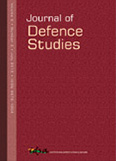Four Decades of UNIFIL: Mandates, Contributions and Challenges
Established in 1978 with the objective of ensuring Israeli withdrawal from South Lebanon, the United Nations Interim Force in Lebanon (UNIFIL) has been a key factor in maintaining stability along the Blue Line between Israel and Lebanon since then. There are divergent views on the achievements of the mission after more than four decades of its deployment.
- Prasanta Kumar Pradhan |
- July-September 2022 |
- Journal of Defence Studies





